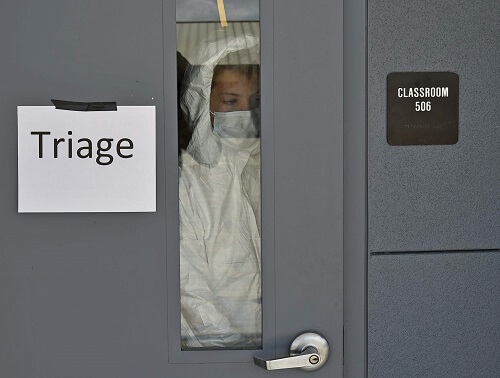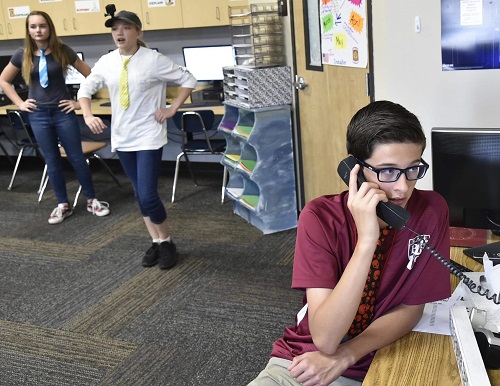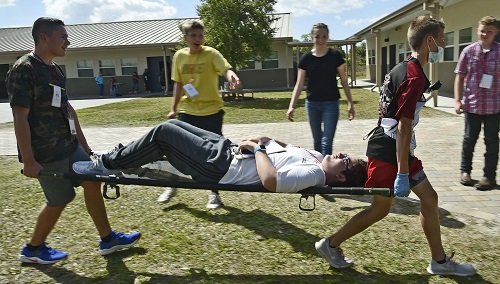WORKSHOP: BUILDING INTERACTIVE GAMES FOR TEACHING & LEARNING
COMPARATIVE JUDGMENT AND ADAPTIVE COMPARATIVE JUDGMENT: DO THEY HAVE A FUTURE IN PEER ASSESSMENT?

Introduction
Simulating a real-world infectious disease outbreak is vital to education. By leveraging widely available technology, we can build and shape our insight into human behavior during outbreaks. Operation Outbreak (O2) is a learning platform that creates a real-time means of emotional and behavioral preparation that may illustrate how chaos, fear and conflicts alter the decision-making capabilities of humans in a demanding environment.
In 2014, during the largest Ebola outbreak in history, students from SMA Prep in Sarasota, Florida, began to show concern for not only the affected countries, but for themselves as well. As the outbreak dominated the headlines, there was a subtle unease that gave way to misinformation, which in turn began to fuel paranoia. Conversely, due to the lack of understanding of outbreak response, the students were confused as to how a pathogen could spread so quickly and wreak havoc amongst a population. Because of this, Dr. Todd Brown felt it necessary to take advantage of their curiosity and desire to learn more by creating an experiential learning simulation.
Initially, the campus-wide outbreak used a sticker-based system that mimicked a pathogen spread by human to human contact. This system caught the attention of Dr. Pardis Sabeti, a Harvard University professor and Broad Institute member, whose lab studies genome biology and infectious diseases. Through Dr. Sabeti’s guidance and collaboration with Dr. Brown, the simulation took hold as an annual event for teaching and learning about outbreak preparation and response. Later, Dr. Andres Colubri, a computational researcher at the Sabeti Lab, was introduced into the program. Dr. Colubri elevated the simulation’s realism even further with the introduction of a one-of-a-kind mobile app. His app was able to mimic an airborne pathogen that “spreads” using Bluetooth technology. The collaborative effort between the three doctors became an experiential learning module called Operation Outbreak (O2); a module with the goal of teaching students the mechanisms of outbreak response and containment from the perspective of public health and governance.

Experiential learning is not a new concept; one of its founders, John Dewey, introduced the idea as far back as 1938. Using the digital world to simulate an infectious disease pandemic isn’t uniquely new either. A memorable example of the latter is a ‘glitch’ in the online role-playing game The World of Warcraft. In 2005, players experienced a ‘glitch’ in the game, which inadvertently created an infectious disease outbreak scenario. This incident is known as Corrupted Blood. While unintentional, the consequences were considered useful, as players exhibited very similar behaviors as what is seen in a real outbreak scenario. These behaviors included players showing empathy for those infected, trying to help infected players and trying to isolate oneself from the spread of the pathogen.
What is novel about O2’s approach is combining didactic and experiential methods with readily available technology, bringing the digital world into reality. While there have been other efforts (such as the BBC Pandemic Project) O2 is novel in that it is not a retrospective algorithm-based simulation. O2 is grounded in real-time, human interactions based on an invisible threat; this distinction provides vital insight into how human behavior may affect an outbreak itself.

Through using mobile devices, which are utilized increasingly often within schools, O2 has created a novel approach to integrating technology into experiential learning. By creating an immersive, adventure-game environment, O2 allows for the digital world to become real, creating a real-time scenario in which a human population can step into a highly advanced technology-based simulation while remaining grounded in their day-to-day surroundings. O2 allows any student body, housing complex and workplace to prepare for a public health emergency, and also allows researchers and their target populations to better understand the sociological implications of an outbreak before stakes become life-threatening. In conducting such a digital simulation in the real world, O2 can offer a unique social and scientific experience that provides data generation and epidemiological modeling of real-life outbreaks. Rapid response and behavioral understanding of a real-life pandemic are vital, and the role of community awareness and preparedness is critical. Furthermore, as vaccinations have become a hot button political issue, O2 provides an adventure game-based alternative that allows for individuals to better understand related topics as herd-immunity in a more meaningful way.
Leading up to the simulation experience, students and teachers engaged in a two week unit that integrated both civics and science. This allowed students to understand biological sciences better as they pertain to infectious agents, as well as the roles of governments, non-government agencies, clinicians, military and media during a crisis. The O2 simulation was a culmination of the unit that was entirely student-driven, as students stepped into the roles mentioned above as well as the general population. During the simulation, students faced the possibility of infection while carrying out these roles. “Symptomatic” students presented in the triage room and shared their symptoms with the clinicians. The clinical team passed along this information to the student epidemiologists, who tried to identify the disease and attempted to stop it from spreading. The epidemiologists then relayed their conclusions to the government officials, so they can best decide what actions to take.

In providing simulations like O2, students can not only take on the roles of various organizations but also, and perhaps more importantly, prepare themselves emotionally and behaviorally for outbreak scenarios. They can gain first-hand knowledge of how emotions such as fear, paranoia, and self-service, can disrupt the decision-making process. As students have to self-report their systems and experiences, they can better understand how personal decisions can affect the group as a whole. Students’ behaviors reflect what has been seen in real outbreaks. For example, some students would “screenshot” the health emoji in order to conceal their sickness, making them able to stay in the simulation and spread the pathogen to others while not self-reporting. Another example of note was the videoing of government officials, who were captured trying to secure access to vaccine stocks before other students in the simulation, and were exposed by the media. One student described the experience as “probably the most real thing I have ever done. You are actually working against the clock while the virus is spreading.”
O2 and its iterations demonstrate that there are limitless possibilities to outbreak simulation technology. There are opportunities to develop more sophisticated models for small populations, as well as develop an economic model on top of the existing technology, which will increase the realism of the project and add the ability to explore individual and community resilience. Ultimately, we can incorporate an evolving pathogen, which can enable transmission tracking and potentially cause new traits and symptoms to emerge. We can also integrate data analytics into the system so that student epidemiologists can carry out visualization and modeling of the generated data with the app.
Using simulations that combine didactic methods with experiential learning, individuals can come to better understand the importance of evaluating their decisions in a time of need and crisis. These experiences may increase empathy for suffering areas, as students experience first-hand how challenging it is for a scientist fighting a disease, a healthcare worker aiding patients or a government official executing an effective response to an emergency. O2 not only provides a safe and realistic platform for teaching and learning at any level, but also drives interest within the STEM fields towards projects oriented towards public health and the wellbeing of the global society.
Authors:
Todd Brown is a teacher and winner of the Ignite Education Innovation Award, The Henry Ford Innovator Award, and is a US Congressional Teacher of the Year.
Andres Colubri is a computational researcher at the Sabeti Lab. He develops machine learning and visualization tools for biomedical data sets and contributes to Processing, a programming language for arts and design.
Pardis C. Sabeti is a professor at Harvard University and the Harvard T.H. Chan School of Public Health, at the Broad Institute of MIT and Harvard, and the Howard Hughes Medical Institute.

